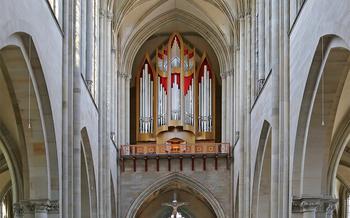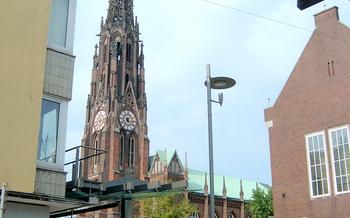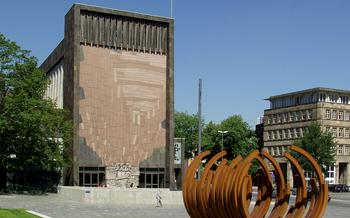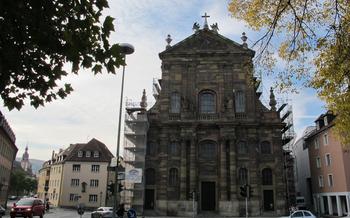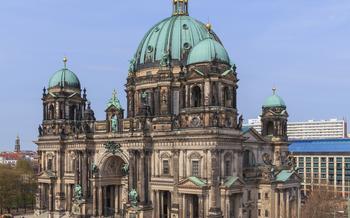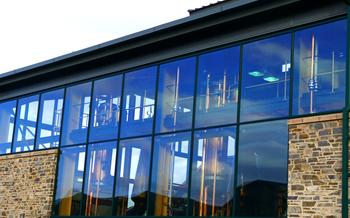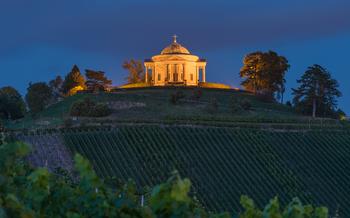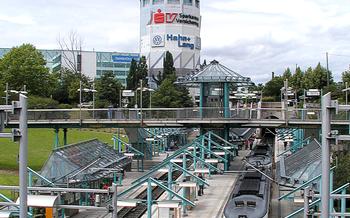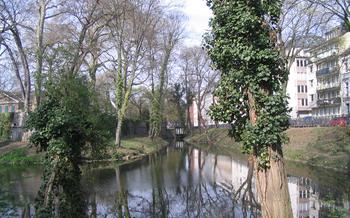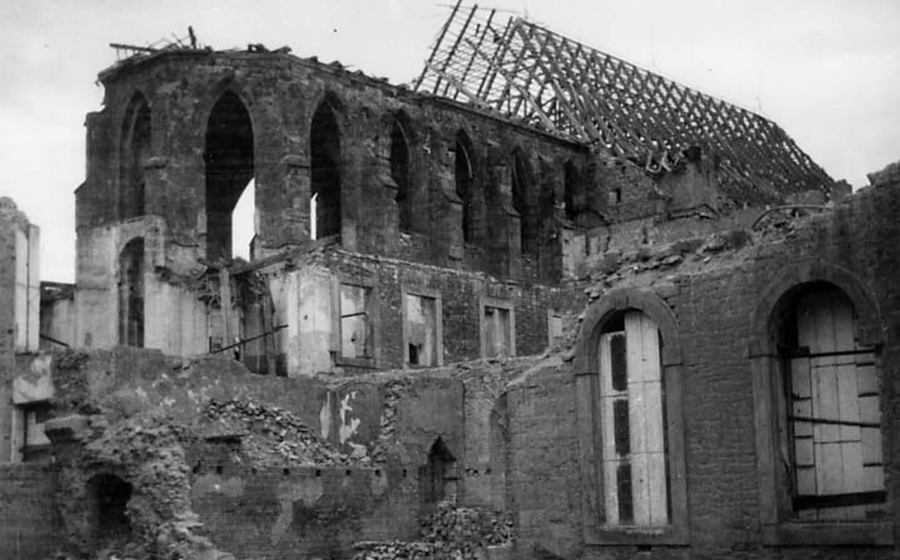
Sepulchral Chapel of Celle
- Architectural Masterpiece
- Interior Beauty
- Tombs and Epitaphs
- Unique Frescoes
- Stained Glass Windows
- Guided Tours
- Opening Hours and Admission
- Nearby Attractions
- Accommodation Options
- Food and Drinks
- Shopping Opportunities
- Insider Tip
Architectural Masterpiece
The Sepulchral Chapel of Celle is a magnificent example of Gothic architecture, showcasing the intricate craftsmanship and artistic vision of the medieval period. Constructed primarily of red brick, the chapel's exterior is adorned with glazed tiles that create a striking visual contrast. The intricate carvings and sculptures that grace the chapel's facade depict biblical scenes and figures, adding depth and symbolism to the overall design. The chapel's soaring spires and graceful arches blend harmoniously with the surrounding landscape, creating a sense of awe and grandeur. The chapel's exterior is a true testament to the architectural prowess of the House of Welf and reflects their commitment to artistic excellence.
Interior Beauty
The interior of the Sepulchral Chapel of Celle is a testament to the artistic and spiritual devotion of the House of Welf. Intricate frescoes and vibrant stained glass windows adorn the walls, creating a breathtaking spectacle of color and light. The frescoes, painted by unknown masters in the 14th century, depict scenes from the life of Christ, including his birth, crucifixion, and resurrection. The vivid colors and expressive brushstrokes bring the biblical narratives to life, inviting viewers to contemplate the profound mysteries of faith.
The stained glass windows, crafted by skilled artisans in the 15th century, showcase a dazzling array of biblical and historical figures. Saints, prophets, and angels gaze out from the windows, their colorful robes shimmering in the sunlight. The windows also depict scenes from the history of the House of Welf, celebrating the dynasty's illustrious lineage and their role as patrons of the arts. Together, the frescoes and stained glass windows create a harmonious and awe-inspiring atmosphere, immersing visitors in a world of beauty and spirituality.
Tombs and Epitaphs
The Sepulchral Chapel of Celle is home to the elaborate tombs of the dukes of Celle and their families, each a testament to their power, prestige, and legacy. These tombs are adorned with intricate carvings, sculptures, and epitaphs that provide valuable insights into the lives and times of the deceased.
The symbolism and iconography used in the tomb designs are particularly noteworthy. For example, the tomb of Duke Otto I features a sculpture of the duke on horseback, symbolizing his military prowess and leadership. The tomb of Duchess Eleonore d'Olbreuse, on the other hand, is adorned with intricate carvings of flowers and vines, representing her beauty and grace.
The epitaphs inscribed on the tombs are equally fascinating, offering glimpses into the personalities and accomplishments of the deceased. Duke George William, for instance, is remembered as a wise and just ruler, while Duchess Sophia Dorothea is praised for her beauty, intelligence, and piety.
These tombs are not merely works of art; they are also valuable historical documents that shed light on the House of Welf and its role in shaping the history of Celle and the surrounding region. Visitors to the chapel can learn a great deal about the dukes and their families by studying these elaborate memorials.
Unique Frescoes
The Sepulchral Chapel of Celle is renowned for its extraordinary cycle of frescoes, which depict scenes from the life of Christ with remarkable artistry. These frescoes, created in the 14th century, hold immense significance in the context of medieval art. They serve as a testament to the artistic patronage of the House of Welf and reflect the deep religious devotion of the era.
The frescoes are executed with intricate detail and vibrant colors, showcasing the exceptional skill of the medieval artists. They narrate the life of Christ chronologically, beginning with the Annunciation and concluding with the Ascension. Each scene is meticulously composed, capturing the essence of the biblical stories with emotional depth and realism.
The frescoes in the Sepulchral Chapel are not merely decorative elements; they serve a didactic purpose. They were intended to educate and inspire the faithful, visually conveying the teachings of the Bible. The vivid depictions of Christ's miracles, parables, and interactions with his disciples aimed to strengthen the faith of those who visited the chapel.
Art historians and scholars have extensively studied the frescoes, marveling at their artistic merit and historical significance. The frescoes provide valuable insights into the iconography and symbolism of medieval art, shedding light on the religious beliefs and practices of the time. They are considered among the finest examples of Gothic fresco painting in northern Germany and continue to captivate visitors with their beauty and spiritual power.
Stained Glass Windows
The Sepulchral Chapel of Celle is renowned for its exquisite stained glass windows, which bathe the interior in a kaleidoscope of vibrant colors. These magnificent windows date back to the 14th and 15th centuries and depict a variety of biblical and historical scenes with remarkable detail and artistry.
The windows on the south side of the chapel illustrate scenes from the Old Testament, including the creation of the world, the story of Adam and Eve, and the flood. The windows on the north side depict scenes from the New Testament, such as the birth of Jesus, the crucifixion, and the resurrection.
One of the most striking windows is the "Resurrection Window," located in the eastern apse of the chapel. This stunning window depicts Jesus rising from the tomb, surrounded by angels and triumphant expressions. The vibrant colors and intricate details of the window are a testament to the skill and artistry of the medieval craftsmen who created it.
The stained glass windows of the Sepulchral Chapel of Celle are not only beautiful works of art but also valuable historical documents. They provide a glimpse into the beliefs and values of the medieval period and offer insights into the lives and legacies of the dukes of Celle and their families.
Guided Tours
To fully appreciate the rich history and symbolism of the Sepulchral Chapel of Celle, consider taking a guided tour. Led by knowledgeable and passionate guides, these tours offer an immersive experience that brings the chapel's stories to life.
Regular group tours are available daily and provide an in-depth exploration of the chapel's architecture, artwork, and historical significance. These tours are ideal for those who want a comprehensive overview of the chapel and its role in the history of Celle.
For a more personalized experience, opt for a private tour. These tours can be tailored to your specific interests and allow you to ask questions and engage in discussions with your guide. Whether you are an art enthusiast, a history buff, or simply curious about the House of Welf, a private tour will provide a deeper understanding and appreciation of the chapel.
To book a guided tour, contact the Celle Tourist Information Center in advance. They will provide you with information on tour schedules, prices, and availability. Whether you choose a regular group tour or a private tour, a guided visit to the Sepulchral Chapel of Celle is an unforgettable experience that will leave you with a lasting impression.
Opening Hours and Admission
The Sepulchral Chapel of Celle is open to the public, allowing visitors to explore its rich history and stunning architecture. The chapel's opening hours vary depending on the season, with extended hours during the summer months. Generally, it is open from Tuesday to Sunday, with specific hours varying throughout the year. It is advisable to check the chapel's official website or contact the local tourist information center for the most up-to-date information on opening hours.
Admission to the chapel is charged, with separate fees for adults, children, and families. Discounts are available for students, seniors, and groups, making it accessible to visitors from all backgrounds. Additionally, there are special events and free admission days throughout the year, offering visitors the opportunity to experience the chapel's beauty without any cost. It is recommended to check the chapel's website or contact the tourist information center for details on these events.
Nearby Attractions
The Sepulchral Chapel of Celle is surrounded by a wealth of historical and cultural attractions, inviting visitors to explore the rich heritage of the city. Just a short walk from the chapel, visitors can discover the Celle Castle, a magnificent Renaissance palace that served as the residence of the dukes of Celle. The castle houses several museums, including the Celle Museum, which showcases the history and culture of the city.
Another must-see attraction is the Old Town of Celle, with its charming cobblestone streets, half-timbered houses, and picturesque canals. Visitors can stroll through the Old Town, admiring the beautiful architecture and exploring the many shops, boutiques, and cafes that line the streets.
For those interested in art and culture, the Bomann Museum is a must-visit. The museum houses a collection of over 100,000 works of art, including paintings, sculptures, and decorative arts from the Middle Ages to the present day.
To experience the natural beauty of the region, visitors can head to the nearby Südheide Nature Park, a vast expanse of forests, heathlands, and lakes. The park offers a variety of outdoor activities, including hiking, biking, and swimming.
By combining a visit to the Sepulchral Chapel of Celle with these other attractions, visitors can gain a deeper understanding of the city's rich history, culture, and natural beauty.
Accommodation Options
When planning your visit to Celle and the Sepulchral Chapel, a variety of accommodation options are available to suit different preferences and budgets. Whether you seek a cozy guesthouse, a modern hotel, or a charming vacation rental, you'll find suitable options within easy reach of the chapel.
For a budget-friendly stay, consider the Jugendherberge Celle, a youth hostel located a short walk from the chapel. It offers basic yet comfortable rooms, shared bathrooms, and a communal kitchen for preparing meals.
If you prefer a more upscale experience, the Hotel Celler Hof is an excellent choice. Situated in the heart of Celle's historic center, this elegant hotel offers spacious rooms, a restaurant serving regional cuisine, and a wellness area with a sauna and fitness center.
For a unique and immersive experience, opt for a vacation rental or apartment. Airbnb and Booking.com list various options within walking distance of the chapel. These rentals offer the comfort and privacy of a home away from home, often with fully equipped kitchens and living spaces.
No matter your budget or preferences, you'll find suitable accommodation options in Celle to complement your visit to the Sepulchral Chapel and explore the city's other attractions.
Food and Drinks
After immersing yourself in the history and beauty of the Sepulchral Chapel of Celle, you may want to indulge in some culinary delights to complete your visit. Fortunately, the area surrounding the chapel offers a range of dining options to satisfy every palate.
For a traditional German meal, head to one of the cozy restaurants or taverns located within walking distance of the chapel. These establishments often serve hearty dishes such as schnitzel, bratwurst, and sauerkraut, accompanied by refreshing German beers.
If you prefer international cuisine, there are several restaurants nearby that offer a diverse selection of dishes from around the world. From Italian pizzas and pastas to Asian noodles and curries, you'll find something to suit your taste buds.
For a quick bite or a refreshing drink, there are several cafes and bakeries in the area. Enjoy a cup of coffee and a slice of cake, or try a traditional German pastry like a pretzel or a strudel.
No matter what your preference, you'll find plenty of dining options near the Sepulchral Chapel of Celle to satisfy your hunger and thirst. So, take a break from your sightseeing and savor the delicious flavors of this historic city.
Shopping Opportunities
After immersing yourself in the history and beauty of the Sepulchral Chapel of Celle, you may want to take home a souvenir or two to remember your visit. Fortunately, there are several shops and boutiques located near the chapel that offer a variety of unique and memorable items.
For those looking for traditional German souvenirs, the "Celler Laden" is a must-visit. This charming shop offers a wide range of local products, including handmade crafts, regional delicacies, and traditional clothing. You can find everything from cuckoo clocks and beer steins to hand-painted ceramics and wooden toys.
If you're interested in more contemporary souvenirs, the "Kunst & Design Galerie" is a great option. This gallery showcases the works of local artists and designers, including paintings, sculptures, jewelry, and home décor. You're sure to find something unique and special to take home as a reminder of your time in Celle.
By supporting these local businesses, you not only get a unique souvenir but also contribute to the preservation of the area's cultural heritage. Whether you're looking for a traditional German keepsake or a more contemporary piece of art, you're sure to find something special near the Sepulchral Chapel of Celle.
Insider Tip
Unlock the secrets of the Sepulchral Chapel of Celle with this insider tip: For a truly immersive experience, plan your visit to coincide with one of the chapel's special events or guided tours. These events often feature reenactments, historical demonstrations, or lectures by experts, providing a deeper understanding of the chapel's history, architecture, and significance. Check the chapel's website or contact the local tourist office for more information on upcoming events and guided tour schedules.
